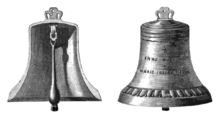Bourdon (bell)
The bourdon is the heaviest of the bells that belong to a musical instrument, especially a chime or a carillon, and produces its lowest tone.
As an example, the largest bell of a carillon of 64 bells, the sixth largest bell hanging in the world, in the Southern Illinois town of Centralia, is identified as the 'bourdon.' It weighs 5,000 kilograms (11,000 lb) and is tuned to G. In the Netherlands where carillons are native, the heaviest carillon is in Grote Kerk in Dordrecht (South Holland).

The biggest bell serving as bourdon of any carillon is the low C bell at Riverside Church, New York City. Cast in 1929 as part of the Rockefeller Carillon, it weighs 19,000 kg (41,000 lb) and measures 3.10 m (10 ft 2 in) across. This is also the largest tuned bell ever cast.
Although carillons are by definition chromatic, the next bell up from the bourdon is traditionally a whole tone higher in pitch, leaving a semitone out of the instrument.
English-style ring of bells
The heaviest bell in a diatonically tuned English-style ring of bells (change ringing) is called the tenor. If a larger, heavier bell is also present it would be called a bourdon.
